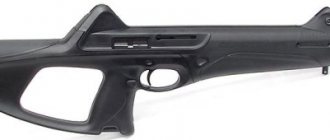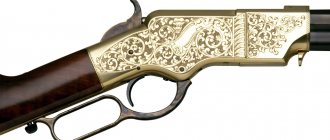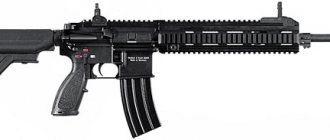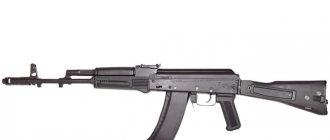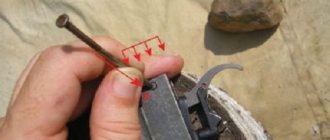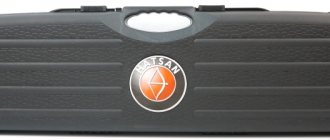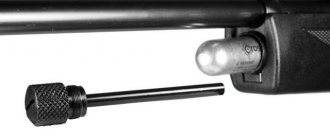Description of the Umarex Cowboy Rifle air rifle
The presented rifle will interest the user at the appearance stage, because the weapon is designed to match the cowboy Winchesters, glorified through a lot of westerns and TV series.
The metal body has a black color, and the texture that is artificially created on the metal surface improves the grip of the product on the hand.
The stock and fore-end are made of wood, which is subsequently coated with a special varnish. The work of the varnish component is to improve the water-repellent properties and also increase the life of the tree. The varnish also protects the structure from scratches and chips that appear during use, thereby maintaining its original appearance.
The design is built around gas-cylinder pneumatics, the power principle of which is based on the use of 12 gram cylinders of compressed air. The advantage of such cylinders is their reduced cost, as well as an improved projectile flight speed.
Shooting is carried out thanks to metal balls of 4.5 mm caliber. Such ammunition boasts an improved, streamlined design that improves the flight speed and aerodynamics of the ball.
At the same time, the speed that the ball is capable of developing when fired is 175 meters per second . The indicator consists of two factors, the first being the power of the compressed air used.
A secondary factor is the smooth barrel, which increases the speed of the ball as it leaves the barrel. Also, smooth-bore products are less picky about cleaning and have an increased lifespan.
The product holds up to 10 cartridges inside, which imitate combat bullets in appearance. A ball is placed inside such a cartridge, and then, using the side window, it is canonically charged inside the hard drive.
It is worth noting that the manufacturer equipped the air rifle with an original method for removing cartridges, because after cocking the Henry bracket, the bolt ejects the empty cartridge case like a combat model.
Thus, using a weapon brings a lot of emotions, because when loading, firing and reloading, the user gets the feeling of shooting from a combat hard drive. The effect is also achieved using the cocking trigger, located in the rear part of the structure.
The cans used as food are placed in the butt of the product, which is opened by turning a special plug. Under the removable backplate there is a clamping screw, which is unscrewed using an integrated hexagon on the inside of the backplate.
The product also has a line fuse, which is installed on the back of the model. With its help, the user can both switch the weapon to combat mode and put the weapon in safe mode.
Volcanic pistols. The truth about Henry's brace
There is probably no one among the people who, at least once in their life, even on a TV screen, has not seen a weapon with a Henry brace. One can immediately recall any film about the “gold rush” in North America or the more famous and popular “Terminator”, in which still young Arnie used a sawed-off Winchester 1887 to destroy everything that came in his way, while instantly reloading the weapon with one hand, holding him by Henry's brace. The Henry brace, also known as the Henry lever, is a lever that, in its normal position, is adjacent to the butt of the weapon, in such a way that the hand holding the handle fits its fingers into an elongated ring for them in the lever itself. Holding the weapon by the fore-end, the lever can be pulled down and returned to its place, while reloading will occur, and the hand will again lie down for a comfortable hold of the weapon. This device is named after Benjamin Henry.
Until recently, I, like many, thought that this man was the inventor of such a truly convenient and original device, but the information found not only allows me to doubt this, but also completely proves that this man has very little to do with the weapon part called in his honor. I will try to present my thoughts and information found in this article.
It all started when someone gave me an article about Volcanic pistols, a truly original weapon and, more importantly for that time, multi-charged. So, the pistol was a rather beautiful device, which, in addition to beauty, was simple and reliable, like a hammer. The pistol was fed from a tubular magazine located under the barrel of the weapon, and reloading was carried out using a miniature Henry clip, which included only one middle finger of the holding hand. I don’t know what in this design gave me the idea to compare the dates of patents for weapons, apparently, the Volcanic is little known nowadays, unlike long-barreled weapons with a Henry brace, and as you know, the original designs are much less widespread, than their modifications. So the result of the comparison was that Volcanic pistols were patented on February 14, 1854, while the first rifle received its patent in 1860. And now the most interesting thing, in fact, the inventors of the Henry staple turned out to be Horatio Smith and Daniel Wesson, who later founded the world-famous company Smith & Wesson. This is the historical fact that was revealed in the process of studying the Volcanic pistol; I think that I was not the only one who was mistaken about the authorship of the Henry staple, which should rightfully bear the name of other famous gunsmiths. However, with Winchester weapons, not everything has always been smooth and straightforward in terms of names, so this fact cannot be said to have greatly surprised me. Let's try to take a closer look at the pistol and its design, developed by Horatio Smith and Daniel Wesson.
So, the Volcanic pistol was created by two famous gunsmiths in 1854. This invention was supposed to completely revolutionize the world of firearms, significantly increasing the speed of fire, but pistols did not become widespread. Despite the fact that the weapon cannot in any way be called mass distribution, it was still mass-produced, which means there were buyers for these pistols. It was with these weapons that Smith and Wesson announced themselves to the world, founding their first company to produce these pistols on June 20, 1854. It specialized exclusively in the production and repair of Volcanic pistols, and was located in the state of Connecticut in the city of Norwich. At this time, the inseparable gunsmith companions began producing pistols in just two calibers, .30 and .38, with barrel lengths of 4 and 8 inches, respectively, and even managed to produce 1,200 weapons, after which their company closed.
The reasons for closing the company were quite compelling. The fact is that initially, not the most successful ammunition for the weapon was chosen. The characteristics of the cartridges were quite satisfactory, but their price was not the smallest, which, naturally, did not contribute to the widespread use of weapons. So, for 1000 cartridges of .30 caliber you had to pay 10 dollars, for 1000 cartridges of 32 hundredths of an inch caliber they demanded 12 dollars, which at that time was not at all small. However, this did not stop the gunsmiths. Having found partners who saw the potential of weapons, among whom was the well-known Winchester, Smith and Wesson opened a new company, within the walls of which they began producing pistols for the most common ammunition at that time. Fundamentally, the new pistols were no different from the previous ones, but given the fact that they began to use quite different cartridges, it took time for production to work at full capacity. Thus, in the first year, only 600 weapons were produced, which were far from the most popular. This time the production was located in New Haven.
Soon, Smith and Wesson left the company, unfortunately, it is unknown for what reason, although, most likely, due to the fact that their truly revolutionary invention in firearms turned out to be unclaimed. In the end, only one of the founders remained, Winchester, who first continued to produce these pistols, and subsequently, with the help of his designers, adapted the design of the pistol for long-barreled weapons. It was precisely this that became the most famous and popular at that time, and over time the pistols were simply forgotten. They also forgot where the Henry brace came from, what kind of weapon it was that preceded the long-barreled models, and who its author was. However, Smith and Wesson received their recognition even without their first invention. The operating principle of the pistol is quite simple. When the bracket is pulled down, the trigger mechanism of the weapon is cocked, and at the same time a new cartridge is picked up from the tubular magazine under the barrel. When the bracket returns to its original position, the cartridge is sent into the chamber, and it becomes securely locked; even the most powerful modern cartridge will not be able to move the bracket back when fired, since all the energy goes into the shooter’s hand in the form of recoil. Well, pressing the trigger releases the firing pin or hammer, depending on the design of the weapon, after which everything repeats. It should be noted that when using only the middle finger, which is included in the ring of the staple, the convenience of the weapon was very, very relative. First of all, the reason for this was the use of gunpowder of a completely different quality from modern ones, which formed a lot of soot. In view of this, not everyone had the strength to remove the spent cartridge case and insert a new cartridge into the chamber. However, when using the weight of the weapon when reloading, this procedure became much easier and faster. True, only models with a long barrel were suitable for this. Apparently, this was the main reason why the weapon was not the greatest success; after all, it required a certain skill from the shooter.
The operating system of the pistol is not particularly interesting, since it repeats (or rather, vice versa) the operation of the circuits of rifles and shotguns with a Henry brace. Equipping a pistol's under-barrel magazine with ammunition is of much greater interest. So, having moved the latch, it was necessary to move the magazine to the side, so that it came out of the frame of the pistol, inserting cartridges into it one by one, it was necessary, holding them with a finger, to return the magazine back and fix it. Naturally, the magazine capacity depended entirely on the length of the pistol barrel, since usually these two elements were equal in length. This not-so-convenient magazine design at that time significantly increased the reloading speed, but it was still better than inserting each new cartridge into a new chamber of the revolver’s cylinder, so we can say that with the advent of the Volcanic pistol, the time for reloading and equipping the weapon with cartridges was significantly reduced . In general, it should be noted that this pistol of a fairly simple design had a huge impact on the further development of weapons, so that, despite the small number of copies produced, this pistol really made, albeit a small, revolution in the arms market, however, only after since it was discontinued. By the way, there were other models of pistols of a similar design, but about them some other time.
Naturally, no one is going to accuse Henry of stealing an idea; after all, the arms business is an industry where the line between plagiarism and a great idea is very thin. It should be noted that the designer adapted the Volcanic pistol system for long-barreled weapons, made the reloading ring more convenient, but naming a separate part in his honor without indicating anywhere the true authors of the operating principle itself was, in my opinion, not entirely good. Still, there is a difference when different designers develop the same system, and everyone knows about it, and the designers themselves use each other’s work, and when one of the designers takes a weapon operating scheme developed by another person and calls it by his own name. I would like to believe that the name was still an initiative of Winchester, and not the designer himself, since when an entrepreneur does this, it is somehow expected and not surprising, because it is thanks to such not entirely honest actions that most famous entrepreneurs have achieved success .
Characteristics of the Umarex Cowboy Rifle air rifle
| Caliber | 4.5 mm |
| Speed | 175 m/s |
| Number of charges | |
| View | Pneumatic rifle |
| Sighting rail Weaver (Picatinny) / Dovetail 11 mm | No |
| Fuse | Eat |
| Manufacturer | Umarex |
| Shooting mode | Single |
| Combat prototype | 19th century cowboy rifle |
| Country of Origin | Germany |
| Type | Gas pneumatics |
| Stock material | Tree |
| Length (mm) | 996 |
| Weight | 2.5 kg |
| Type of ammunition | Metal balls |
| Color | Tree |
| Barrel type | Smooth |
| Energy source | 12 gram CO2 cans |
| Blowback | No |
| Housing material | Metal |
| Equipment | Rifle, packaging, brief documentation, copy of certificate (upon buyer's request) |
| certificate |
Air rifle Umarex Cowboy Rifle (Henry clip) buy in the Popadiv10 online store. Air rifle Umarex Cowboy Rifle (Henry clip) at a low price of RUB 27,290. You can pay for your order by mail upon receipt in any part of the Russian Federation. Before placing an order, be sure to check the price and contents of the product by phone (during business hours) or by e-mail and feedback system (at any time convenient for you).
The information on the product “Umarex Cowboy Rifle Air Rifle (Henry Brace)” is for informational purposes only and is not a public offer as defined by the provisions of Article 437 of the Civil Code of the Russian Federation; characteristics, appearance, color and equipment may be changed by the manufacturer without notice.
Advantages and disadvantages
The advantages of the 1887 hard drive include:
- eye-catching design;
- reliability of design;
- comfortable ergonomic shape;
- convenience of quick shooting;
- ease of use;
- common caliber.
Flaws:
- inability to re-equip the magazine during use;
- rarity of spare parts;
- high cost;
- Winchester 1887 models used black powder cartridges, which is not always convenient.
Price 1887 from Chiappa Firearms $1300 - $1700
Specifications
| Marlin 1895 | |
| Charging type | Lever Action |
| Caliber | .45-70 Government |
| Trunk | Round |
| Barrel length (mm) | 559 |
| Rifling | 6 right-hand deep-cut Ballard-type |
| Rifling pitch | 1:20” |
| Magazine capacity | 4 |
| Lodge | Semi-pistol, American walnut |
| Overall Length (mm) | 1029 |
| Weight without cartridges (kg) | 3,4 |
| Marlin 1895CB | |
| Charging type | Lever Action |
| Caliber | .45-70 Government |
| Trunk | Hexagonal |
| Barrel length (mm) | 660 |
| Rifling | 6 right-hand deep-cut Ballard-type |
| Rifling pitch | 1:20” |
| Magazine capacity | 9 |
| Lodge | Straight English, American walnut |
| Overall Length (mm) | 1130 |
| Weight without cartridges (kg) | 3,8 |
| Marlin 1895CBA | |
| Charging type | Lever Action |
| Caliber | .45-70 Government |
| Trunk | Hexagonal |
| Barrel length (mm) | 470 |
| Rifling | 6 right-hand deep-cut Ballard-type |
| Rifling pitch | 1:20” |
| Magazine capacity | 6 |
| Lodge | Straight English, American walnut |
| Total length (cm) | 940 |
| Weight without cartridges (kg) | 3,6 |
| Marlin 1895G, Marlin 1895GS | |
| Charging type | Lever Action |
| Caliber | .45-70 Government |
| Trunk | Round |
| Barrel length (mm) | 470 |
| Rifling | 6 right-hand deep-cut Ballard-type |
| Rifling pitch | 1:20” |
| Magazine capacity | 4 |
| Lodge | Straight English, American walnut |
| Total length (cm) | 940 |
| Weight without cartridges (kg) | 3,18 |
| Marlin 1895GBL, GSBL, SBL | |
| Charging type | Lever Action |
| Caliber | .45-70 Government |
| Trunk | Round |
| Barrel length (mm) | 470 |
| Rifling | 6 right-hand deep-cut Ballard-type |
| Rifling pitch | 1:20” |
| Magazine capacity | 6 |
| Lodge | Half-pistol, laminated |
| Total length (cm) | 940 |
| Weight without cartridges (kg) | 3,18 |
The Marlin 1895 STP Trapper carbine is discussed in detail in this video:
Design
The Marlin 1895 is a rifle with a tubular under-barrel magazine that is reloaded with a Henry Lever Action.
- The barrel is thick-walled, caliber .45-70 Government. There are hexagonal models. Six deep trapezoidal Ballard rifling.
- The receiver is closed, on the right plane there are two windows - for ejecting cartridges and a magazine hopper, covered with a spring-loaded curtain. The top edge is flat, it has two holes with metric threads for installing optical sights.
- The bolt is round, with one extractor tooth and a flat cylinder mirror. Locking is done with a wedge that fits into a rectangular groove located on the underside of the stem, closer to the shank of the striker. During locking, the firing pin parts are closed, so a shot is possible only if the bolt closes the breech completely.
- The trigger mechanism is cocked by a lever connected to a Henry clip. The hammer can be cocked or released manually to the so-called half-cocked position, when a gap of several millimeters remains between it and the shank of the firing pin, which does not allow the shot to be fired.
- The firing pin does not have a spring and moves freely along the channel in the bolt stem, therefore, if the trigger rests against it and there is a cartridge in the chamber, the primer can be punctured and fired. This case is specifically discussed in the instructions, which require that the shooter control the position of the trigger and be sure to put it half-cocked if for any reason it is in the extreme forward position.
- To mechanically lock the trigger, there is a safety catch, the flag of which is shaped like a button located above the trigger guard, near the butt plate of the receiver. It turns off by moving the button to the left, after which a red ring mark appears on the pin.
- The set of sighting devices consists of a rear sight adjustable vertically and horizontally and a metal front sight in a cylindrical casing.
- Wood stock - solid walnut or laminated. One half of the models is equipped with a semi-pistol stock, the other with a straight English stock. The stock has a straight comb inclined to the axis of the barrel. A shock-absorbing butt pad is installed.
